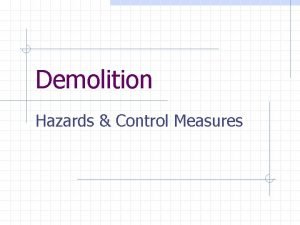CONSTRUCTION AND DEMOLITION SOLID WASTES CHARACTERISTICS ASSESSMENT FOR

- Slides: 1

CONSTRUCTION AND DEMOLITION SOLID WASTES CHARACTERISTICS ASSESSMENT FOR CIVIL ENGINEERING USES Antônio Celso de Sousa Junior; Hêndrio Carvalho Chaves ; Brenno Augusto Marcondes Versolatto; Daniela Belchior. ADVISOR: Prof. Dr. João Alexandre Paschoalin Filho. University Nove de Julho – São Paulo – SP – Brasil INTRODUCTION Construction and demolition wastes have been studied by technical means to develop management tools to reduce their environmental impacts. Among these, recycling can be highlighted. It is also noteworthy that the technical environment does not yet have an appropriate amount of scientific work that presents the study of engineering characteristics obtained for construction waste, which, many times, makes it impossible to consider these for use in civil engineering. Construction and demolition wastes account for 30 to 40% of the total mass of produced solid urban waste all over the world (Jin et al. , 2018). When improperly managed, this waste causes soil, water, and air pollution (Mahpour, 2018). The quantity and the composition of C&DW can vary between different regions depending on many factors such as economic growth, legislation, public policy, constructor expertise, type of constructions, regional planning, and others (Menegaki & Damigos, 2018). It estimated that more than 10 billion tonnes of C&DW was generated over the world in 2017 (Wang et al. , 2019). ACHIEVEMENTS MAIN GOAL Thus, this article demonstrates the obtaining and evaluation of engineering parameters for concrete construction wastes obtained at a C&DW Recycling Plant near São Paulo. To this end, laboratory tests were performed according to relevant technical standards for determining the following characteristics: specific weight, integrity using ultrasound, compressive strength, elasticity modulus, and absorption. METHODOLOGY To verify internal fissures existence that could affect the specimen's compressive strength, ultrasound tests were performed according to ABNT NBR 8802 (2010) recommendations. Compressive tests were performed to obtain specimen's strength following the procedures given by ABNT NBR NM 8522 (2017). The used equipment was a compression press test equipment, model EMIC GR 048 (300 k. N of maximum compressive capacity). Tests were also performed to determine the Elasticity Modulus of the specimens. This procedure was carried out following the recommendations of ABNT NBR NM 8522/2017 CONCLUSIONS Through the results obtained, it is possible to state that the recycled C&DW in its natural state had a specific weight of 22. 35 k. N/m 3; its compressive strength was 30. 05 k. N. The obtained Initial Tangent Elasticity Modulus was 21. 2 GPa, where the C&DW is within a reasonable range of concrete. It is worth noting that the average wave speed obtained employing the ultrasound test for this analyzed set was 5, 617. 70 m/s, where, according to ABNT NBR 8802, it indicates the excellent quality of the tested specimens and the absence of pathologies and non-visible heterogeneities that could influence the proposed tests. The C&DW using consistis in a new alternative to one of the biggest problems faced by civil construction: the destination of the waste generated in the works. Thus, the use of C&DW for civil construction can create and stimulate higher demand for recycled materials in the C&DW Recycling Plants.

